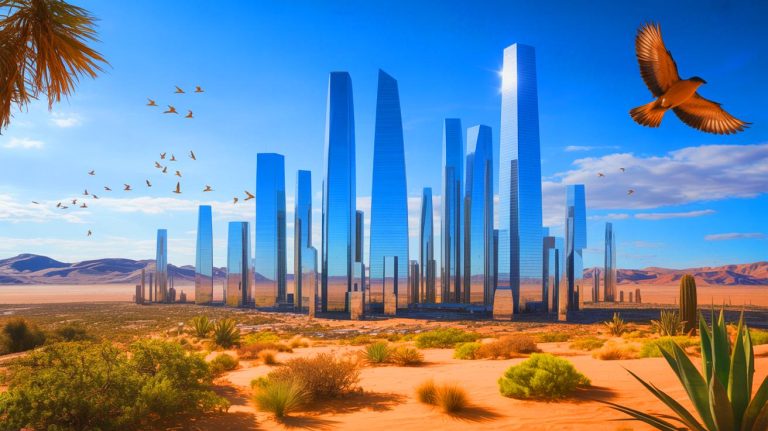“Saudi Arabia to Wipe Out Nature”: 105-Mile Mirror Wall Will Slaughter Tens of Thousands of Birds Across Lifesaving Migration Paths
Saudi Arabia's ambitious Line project, a 105-mile-long urban marvel in the desert, is generating intense debate as it promises futuristic living while raising environmental concerns, particularly regarding migratory birds.

Illustration of The Line project in Saudi Arabia, depicting its futuristic and mirrored cityscape in the desert. Image generated by AI.
IN A NUTSHELL

The Line project aims to transform a 105-mile stretch of Saudi Arabia’s desert into a futuristic cityscape.

Concerns have arisen over the project’s impact on migratory birds due to its mirrored facade and significant location on a major avian route.

The project faces construction challenges and delays, hindering its initial goals of housing nine million residents.

Balancing urban innovation with ecological preservation is crucial for ensuring a sustainable future for The Line.
The Line project in Saudi Arabia is a bold initiative aimed at redefining urban living by creating a futuristic cityscape in the desert. As part of the expansive NEOM development, The Line stretches an impressive 105 miles and aspires to harmonize sustainability with cutting-edge innovation. While the project garners excitement for its audacity, concerns have arisen over its potential environmental impact, particularly its threat to migratory birds that frequent the region. This ambitious project poses significant questions about how urban development can coexist with ecological preservation, urging us to consider the delicate balance between technological advancement and nature.
The Scale and Ambition of The Line
The Line is a cornerstone of Saudi Arabia’s Vision 2030, a transformative endeavor designed to convert a vast desert landscape into an urban marvel. This linear city is projected to extend 105 miles and rise 1,640 feet into the sky, aiming to accommodate nine million residents. The city’s mirrored facade represents a fusion of advanced technology and sustainability aspirations, promising to revolutionize urban living. However, the project’s grand scale has attracted scrutiny from environmentalists concerned about potential biodiversity threats, especially to avian populations.
Environmental assessments have revealed significant concerns about the project’s impact on migratory birds. The towering structure, with its reflective surfaces, poses a serious risk to bird life. Environmentalists argue that the challenge lies in reconciling such grand urban visions with the delicate ecosystems they inhabit. The project’s progress and ultimate success depend on finding solutions to these environmental concerns while maintaining its ambitious urban innovation goals.
Environmental Implications and Avian Threats
Situated on a major migratory route, The Line presents a considerable threat to billions of birds. The mirrored skyscraper could become a lethal barrier for these avian travelers. Developers acknowledge the potential loss of bird life, sparking intense debates about reconciling urban expansion with wildlife conservation.
The table below highlights some of the critical challenges faced by The Line project:

Avian Impact A Threat to Migratory Birds

NEOM Project Desert Transformation into a Futuristic City

Sustainability An Ecological Ambition Under Scrutiny

Delays Cumulative Construction Challenges
The plight of these birds raises broader questions about development in environmentally sensitive areas. How can we ensure our pursuit of innovation does not come at the expense of biodiversity and ecological balance? This dilemma underscores the importance of integrating environmental considerations into urban planning to protect the natural world.
Construction Hurdles and Project Delays
Beyond environmental concerns, The Line project encounters significant construction challenges and delays. Initially anticipated to house nine million residents, current estimates suggest only 300,000 inhabitants by 2030, reflecting a stark deviation from the original vision. Construction is primarily focused on excavation, with numerous foundational challenges hindering progress.
- Construction setbacks
- Balancing nature and urbanization
- Impact on biodiversity
-Project delays
These hurdles highlight the complexities of pursuing sustainable construction within fragile environments. The project’s ambitious goals require overcoming these obstacles while ensuring ecological integrity. As The Line advances, it serves as a poignant case study in the ongoing discourse about sustainable development.
Balancing Innovation and Ecological Preservation
The Line project epitomizes the tension between urban innovation and ecological preservation. Its ambitions are as vast as the desert it seeks to transform, yet the environmental cost cannot be ignored. Balancing technological and architectural progress with nature’s preservation is crucial for ensuring a sustainable future.
As we progress, we must ask ourselves: How can we strike a balance between creating advanced, innovative urban environments and preserving the natural world for future generations? What sacrifices are we willing to make in the pursuit of progress, and how can we ensure that our actions today do not come at the expense of tomorrow’s ecosystem?
Our author used artificial intelligence to enhance this article.
https://www.sustainability-times.com/cl ... ion-paths/



